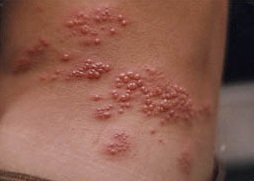 Shingles is a blistered rash appearing in a band, strip or small area of the skin on one side of the body that can be very painful. The condition is due to the reactivation of the varicella zoster virus which was initially contracted when the patient had chickenpox. If you are in close contact with a friend, colleague, or family member with shingles, you may wonder, “How do you catch shingles?” Here’s what you need to know.
Shingles is a blistered rash appearing in a band, strip or small area of the skin on one side of the body that can be very painful. The condition is due to the reactivation of the varicella zoster virus which was initially contracted when the patient had chickenpox. If you are in close contact with a friend, colleague, or family member with shingles, you may wonder, “How do you catch shingles?” Here’s what you need to know.
Can You Catch Shingles?
You will not get shingles through exposure to another person with shingles. However, anyone who has not previously had chickenpox or received the chickenpox vaccine is susceptible to catching the varicella zoster virus from shingles patients. Exposure to the virus occurs through contact with the fluid that is contained in shingles blisters.
Who Will Catch Shingles?
Shingles can develop in anyone who has previously had chickenpox, regardless of the age they had the chickenpox and how old they are now. However, shingles are most frequently seen in patients in their 60s and 70s. The development of shingles in older people is really common, with an estimated half of the population in the US exhibiting some signs of shingles by the time they turn 80. Why and how do you get shingles at this age? Well, reactivation of the zoster virus often occurs when the immune system is weak, so shingles is commonly seen in patients who are sick or stressed, or have other health problems.
Is Shingles Contagious?
You may ask the question “can you catch shingles” and the answer is yes. Then you may wonder “how do you get shingles?” In fact, shingles is not spread through breathing in the virus, so you won’t get the disease from someone sneezing or coughing near you. In fact, shingles is only contagious for those who have never had chickenpox. These people don’t already have the varicella-zoster virus in their body, so they can catch it from shingles patients. If you’ve previously had chickenpox, the virus is dormant in your body. However, it won’t necessarily become reactivated, even if one of your close family members has active shingles.
So how do you catch shingles? When varicella-zoster virus does pass from one person to another, it occurs through direct contact with the open blisters. With fresh oozing blisters, the shingles patient will be contagious to those who have not been previously exposed to zoster virus and those with impaired immune systems. However, these people will develop chickenpox, not shingles. Once the blisters have popped open and become crusty scabs, the shingles patient is no longer contagious.
How to Prevent Shingles
If you have previously had chickenpox, a vaccine called Zostavax can lessen the chances of developing shingles, or at least ease some of the painful symptoms. The vaccine can be prescribed for patients aged 60 plus, regardless of whether they’ve previously had shingles.
People who’ve never had chickenpox may receive the varicella vaccine which prevents chickenpox infection and subsequent shingles. However, if you haven’t received this vaccine and you’ve never had chickenpox, you need to avoid any contact with shingles and chickenpox patients.
If you are currently suffering from shingles, avoid any direct contact with people until the blisters have healed. Be particularly careful with anyone who is at extra risk of contracting chickenpox, including:
- People with a fragile immune system, for example, those with diabetes or HIV, as they cannot defend themselves adequately against the virus.
- Anyone who has never had chickenpox or the vaccine, mostly babies and children. You should also avoid contact with pregnant women.
Cover your sores with an absorptive dressing to stop fluid oozing and to protect the sores. This helps to stop the virus spreading to others.


